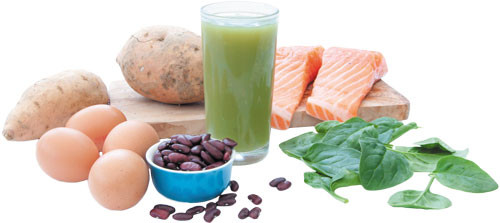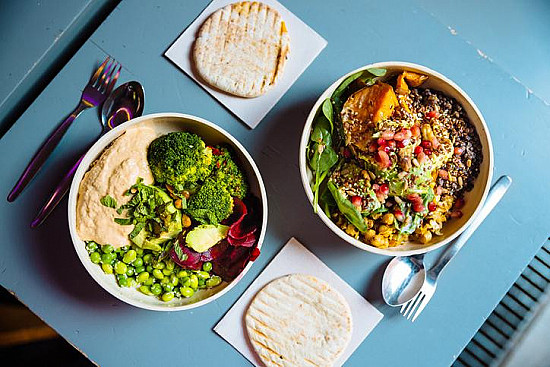Do you eat enough protein?
Obtain the moderate amount of protein you need from a variety of nutritious foods—not just meat.

To meet your daily protein needs, combine small to medium portions of meat, dairy, and nuts with protein-rich whole grains, legumes, and vegetables.
Protein is essential to good health. You need it to make the bricks and mortar of the body, including muscle, bone, and blood. But how much protein does the average man need in order to stay healthy?
The answer is more complicated than you might think. Most Americans take in about 15% of their calories from protein, which is well within recommended daily requirements. However, some research suggests that higher-protein diets may help you maintain a healthy weight or preserve muscle health with aging.
If you decide to boost your daily protein, also consider its impact on your diet as a whole. "If you are not eating much fish and you want to increase protein intake—yes, eating more fish might improve the overall nutrient profile and would subsequently improve your health," says registered dietitian Kathy McManus, director of the Department of Nutrition at Harvard-affiliated Brigham and Women's Hospital. "But I think the evidence is pretty strong against significantly increasing red meat, and certainly processed meat, to get protein."
How much do you need?
The U.S. Dietary Guidelines state that an adult man should take in a minimum of 10% of his daily calories from protein. (In absolute numbers, that's equivalent to 0.36 grams of protein per pound of body weight.) The body breaks the protein down into amino acids and—among other things—uses them to build muscle. Any protein left over is available to fuel energy needs. Each gram of protein you eat contains 4 calories.
Guidelines also say that the healthy range for protein extends up to 35% of daily calories. In practice, it can be difficult to consume that much protein every day without resorting to eating a lot of meat and other animal foods or relying on protein supplement products.
Higher-protein diets and health
Higher-protein diets are often promoted as a way to lose weight. "Patients come to me all the time asking if more protein will help them with weight loss," McManus says. "I tell them the verdict is still out. Some studies support it, some studies don't."
Researchers have also been looking into possible muscle health benefits for men. In middle age, men start to lose muscle mass and function. Over time, this raises the risk of frailty and falls. "I think that aging and loss of muscle is something we really need to pay attention to," McManus says.
But it's not proven that eating a higher-protein diet helps prevent muscle loss. The value of higher-protein diets for cardio-vascular health also remains inconclusive.
On the other hand, boosting protein to 20% or even 25% of daily calories is unlikely to harm you—assuming your overall diet is still nutrient-rich. Men with chronic kidney disease should check with their doctors before substantially increasing the amount of protein in their diets.
What kind of protein is best?
Despite all the pontificating over protein, it pays to remember that healthy diets are based on healthy foods, and some of those foods should contain protein. It's easy for men to get the message that "protein" equals "meat," but there are other foods you can and should eat that contain this key nutrient (see "Protein: Meat and more"). Here are some suggestions to guide your choices:
-
Choose protein sources low in saturated fat. Also avoid highly processed carbohydrates.
-
Protein powders and shakes provide amino acids but offer limited nutritional value. Ready-to-drink shakes may also contain added sugar and other caloric sweeteners, so make sure to read the nutrition label.
-
Unless you are a bodybuilder, you don't really need an extra boost of protein before a strength training workout. The cur-rent 15% protein intake of the average American male, combined with regular exercise, is sufficient to maintain muscle.
Protein: Meat and more |
||
|
Food |
Serving |
Protein (grams) |
|
Roasted chicken breast |
3.5 ounces |
31 |
|
Pink salmon, canned |
3.5 ounces |
20 |
|
Greek yogurt, plain |
6 ounces |
17 |
|
Milk, 2% far |
1 cup |
10 |
|
Beans, cooked |
½ cup |
6-9 |
|
Cheddar cheese |
1 ounce (slice) |
7 |
|
Egg |
1 large |
6 |
|
Nuts |
1 ounce (1/4 cup) |
4-7 |
|
Corn on the cob |
1 large ear |
4 |
|
Baked potato |
1 medium |
3 |
Image: Thinkstock
Disclaimer:
As a service to our readers, Harvard Health Publishing provides access to our library of archived content. Please note the date of last review or update on all articles.
No content on this site, regardless of date, should ever be used as a substitute for direct medical advice from your doctor or other qualified clinician.















